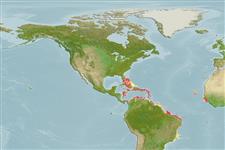分类 / Names
俗名 | 同种异名 | Catalog of Fishes(属, 种) | ITIS | CoL | WoRMS | Cloffa
Teleostei >
Anguilliformes (Eels and morays)
鰻目 (Eels and morays) >
Muraenidae (Moray eels)
鯙科 (Moray eels) > Muraeninae
Etymology: Echidna: Greek, echidna = viper, 1847 (Ref. 45335).
Eponymy: In Greek mythology Echidna was a female monster, and mother of many other monsters including the Hydra. Hesiod described her as “half a nymph with glancing eyes and fair cheeks, and half again a huge snake, great and awful, with speckled skin.” (Ref. 128868), visit book page.
More on author: Bloch.
Environment: milieu / climate zone / depth range / distribution range
生态学
海洋 礁区鱼类; 深度上下限 0 - 12 m (Ref. 9710), usually 0 - 2 m (Ref. 40849). 熱帶; 33°N - 30°S, 82°W - 14°W
Western Atlantic: Bermuda, Florida (USA), and the Bahamas to the Antilles (Ref. 26340) and Brazil. Eastern Atlantic: Cape Verde (Ref. 34514) and Ascension Island (Ref. 4450). The only record from West Africa is probably erroneous (Ref. 4450). Also southern Atlantic islands (Ref. 26938).
西大西洋: 百慕達群島,佛羅里達 (美國), 與巴哈馬到安地列斯群島 (參考文獻 26340) 與巴西。 東大西洋: 維德角 (參考文獻 34514) 與阿森松島.(參考文獻 4450) 可能是的來自非洲西方部的唯一的記錄錯誤的.(參考文獻 4450) 也大西洋南方的島嶼.(參考文獻 26938)
大小 / 重量 / 年龄
Maturity: Lm ? range ? - ? cm
Max length : 165 cm TL 雄鱼/尚未辨别雌雄; (Ref. 26340); common length : 40.0 cm TL 雄鱼/尚未辨别雌雄; (Ref. 5217)
简单描述
检索表 | 型态特徵 | 形态测量图
With short blunt snout, yellow chain-like markings, teeth bluntly pointed or molar-like especially on roof of mouth (Ref. 26938).
有短的钝吻,黄色的像链一样的斑纹,齿顿尖或臼齿状的尤其在嘴的顶部上.(参考文献 26938)
A benthic and solitary species (Ref. 26340) found commonly on reefs and rocky shore areas. Feeds on small fishes and crustaceans (Ref. 5521). At Fernando de Noronha Archipelago, off NE Brazil, forages for sally lightfoot crabs (Grapsus grapsus) on exposed reefs at ebb tide and in tide-pools mostly at daytime. Able to withstand up to 30 minutes out of water while foraging, uses four main tactics both in and out of the water. Searches for prey at pool rims and rock bases poking into crevices and holes, stealthily approaches previously sighted prey, chases prey and ambushes prey from under rocks and crevices. Hunting success varies with employed tactic, but overall success is about 50%. May move up to 6 meters in about 1 hour while foraging on the exposed reef. Its crab hunting is mostly visually guided and a fish darting nearby a stealthily foraging moray may cause it to miss the strike; the missed crab may be chased up to 5 m on the reef. Able to strike with its body partly or entirely out of the water, usually strikes from a distance of 5 to10 centimeters. Small crabs are swallowed whole, whereas larger ones are torn apart by a combination of tugging, rotating, knotting, and thrashing movements. Handling time is related to prey size, the largest crabs (carapace width 2.3-3.2 times larger than moray’s head width) broken up and swallowed within 90 to 240 seconds. Attracted to plastic or rubber decoys dragged on a nylon string nearby, striking at these (Ref. 50922).
一个底栖与独居性的种 (参考文献 26340) 通常在礁与岩岸区域上发现。 吃小鱼与甲壳动物。 (参考文献 5521) 在 Fernando de Noronha 列岛, 外海的
东北巴西,在白天大部份在退潮的暴露礁石上与在潮池中为突击 lightfoot 螃蟹 ( Grapsus grapsus) 觅食。 能抵抗向上到 30 细小的离开水面然而觅食, 使用四个主要的战术中与离开水面。 在水池边缘搜寻猎物与岩石基底进入裂隙与洞之内拨开, 先前暗地里接近看得见的猎物, 猎逐猎物而且埋伏突袭猎物从在岩石与裂隙下面。 猎食成功随着利用战略改变,但是整体的成功是大约 50% 。 当捕食裸露的礁时候,在大约 1 小时中 6 公尺处可以向上移动到。 它的猎食的螃蟹视觉上大部份被引导,而且在附近冲出一暗地里觅食海鳗的一个鱼可能导致它错过攻击; 被错过的螃蟹可能是在礁上猎逐向上到 5 公尺。 能,攻击部分或完全地用它的身体出自
水, 通常攻击从远处 5 到 10个公分。 小的螃蟹被整个吞下,然而较大的一些分别地被用力拉,旋转,打结的组合 , 与猛移运动撕开。 操作的时间被与猎物的大小有关, 在 90 到 240 秒里面瓦解而且吞的最大的螃蟹 (甲壳宽度 2.3-3.2 倍大于海鳗的头部宽度)。 被塑料吸引了或者包以橡皮被打击这些的在附近被拖延尼龙线的引捕器。 (参考文献 50922)
Life cycle and mating behavior
成熟度 | 繁殖 | 产卵场 | 卵 | 孕卵数 | 仔鱼
Oviparous (Ref. 35581).西大西洋: 百慕達群島,佛羅里達 (美國), 與巴哈馬到安地列斯群島 (參考文獻 26340) 與巴西。 東大西洋: 維德角 (參考文獻 34514) 與阿森松島.(參考文獻 4450) 可能是的來自非洲西方部的唯一的記錄錯誤的.(參考文獻 4450) 也大西洋南方的島嶼.(參考文獻 26938)
Robins, C.R. and G.C. Ray, 1986. A field guide to Atlantic coast fishes of North America. Houghton Mifflin Company, Boston, U.S.A. 354 p. (Ref. 7251)
世界自然保护联盟红皮书 (Ref. 130435: Version 2024-1)
人类利用
渔业: 低经济; 水族馆: 商业性
工具
特别资料
下载 XML
网络资源
Estimates based on models
Preferred temperature (Ref.
123201): 26.1 - 28.1, mean 27.4 °C (based on 527 cells).
Phylogenetic diversity index (Ref.
82804): PD
50 = 0.5005 [Uniqueness, from 0.5 = low to 2.0 = high].
Bayesian length-weight: a=0.00049 (0.00024 - 0.00099), b=3.26 (3.10 - 3.42), in cm total length, based on LWR estimates for this (Sub)family-body shape (Ref.
93245).
营养阶层 (Ref.
69278): 3.6 ±0.59 se; based on food items.
回复力 (Ref.
120179): 非常低的, 最小族群倍增时间超过14 年 (Preliminary K or Fecundity.).
Fishing Vulnerability (Ref.
59153): Very high vulnerability (90 of 100).
Nutrients (Ref.
124155): Calcium = 22.6 [11.1, 35.5] mg/100g; Iron = 0.395 [0.221, 0.871] mg/100g; Protein = 18.8 [16.4, 21.4] %; Omega3 = 0.0759 [, ] g/100g; Selenium = 41.4 [20.4, 88.3] μg/100g; VitaminA = 44.8 [10.8, 165.3] μg/100g; Zinc = 0.937 [0.641, 1.355] mg/100g (wet weight);
